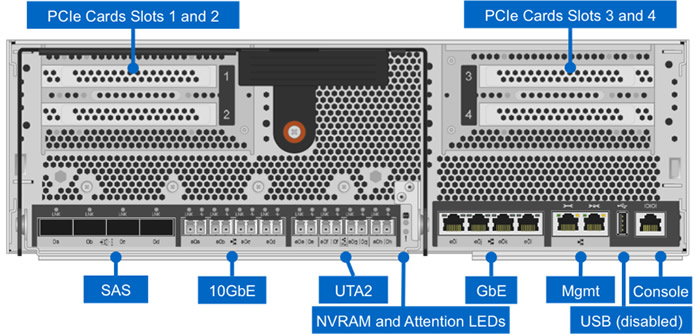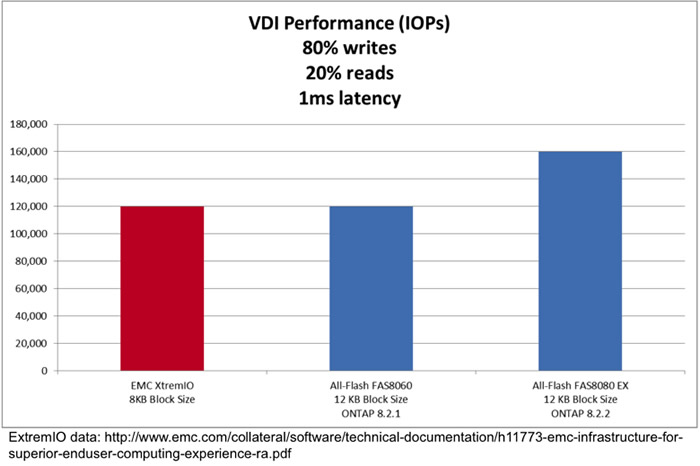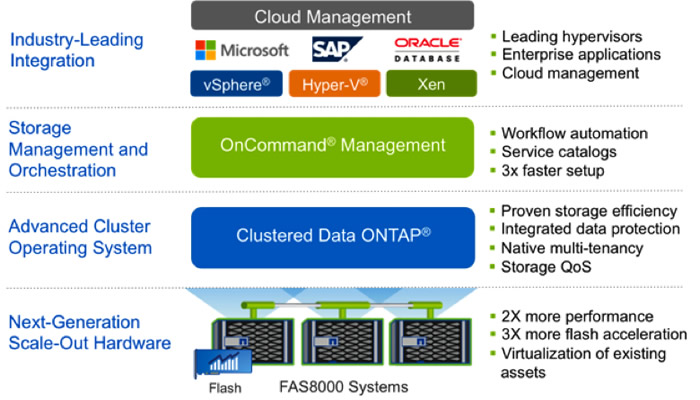


When we introduced the NetApp® FAS8000 a few months back, I'm sure many of you sensed there was still a little something waiting in the wings. That something is the FAS8080 EX, the most powerful, most capable FAS storage system NetApp has ever designed.
 We designed our new flagship FAS system with the raw CPU capacity, massive I/O throughput, and extreme reliability necessary to tackle the most challenging storage tasks, including busy public and private cloud environments and business-critical application workloads such as Oracle® Database and SAP.
We designed our new flagship FAS system with the raw CPU capacity, massive I/O throughput, and extreme reliability necessary to tackle the most challenging storage tasks, including busy public and private cloud environments and business-critical application workloads such as Oracle® Database and SAP.
Like the other members of the FAS8000 family, the FAS8080 EX is designed to run NetApp® clustered Data ONTAP® software, delivering the full payload of nondisruptive operations, advanced storage efficiency, and integrated data protection of clustered Data ONTAP. We've optimized the FAS8080 EX so that it's lightning fast to meet the I/O demands of SSDs in both all-flash and hybrid storage configurations. As you'll see, the results it achieves speak for themselves.
A combination of raw performance, availability, and proven NetApp data management allows the FAS8080 EX to support your most critical workloads. It can scale out to millions of IOPS and tens of petabytes of capacity to support a vast number of diverse storage workloads in parallel.
The FAS8080 EX is similar to its siblings in many respects, including its unified, scale-out architecture and the ability to virtualize other storage arrays using NetApp FlexArray software. If you haven't already done so, you might want to read my FAS8000 article to get the full picture. In this article, I'll focus on the things that make this system unique.
Introducing the FAS8080 EX

The demands that modern data centers put on storage systems continue to grow, due not only to more and faster devices like SSDs, but also because of storage efficiency technologies such as compression, and backend workloads like replication and backup. We simply demand more from a storage system these days, and those demands can overwhelm the CPUs and I/O channels.
I'm well known within NetApp for the saying, "CPU is for show, I/O is for dough," but in this case the FAS8080 EX delivers both tremendous CPU capacity and tremendous I/O to satisfy modern data center demands. Our design philosophy was to take everything users loved about previous generations of FAS—and the FAS8000 itself—to the next level. The additional resources allow us to deliver great topline performance with consistent performance under load.
Ivy Bridge Processors
The first big change for the FAS8080 EX versus the FAS6290 and the other FAS8000 models is in the CPU design. Rather than the Intel® Sandy Bridge processors used in the other FAS8000 models, the FAS8080 EX features the latest Intel Ivy Bridge processors. (This is one of the reasons this model came after the others.) The processors themselves deliver about a 10% bump in performance per core.
In addition, we've increased the number of cores on FAS8080 EX up to 20 per controller (40 cores per HA pair, a 25% increase in core count over the FAS8060), and we've bumped the clock rate up from 2.1GHz to 2.8GHz (a 33% increase). The net is that the FAS8080 EX delivers more than 50% more raw computing power compared to the FAS8060 and FAS6290. The ability to turn that raw compute power into storage work varies depending your workload, but (as you'll see momentarily) we do notice a significant boost in overall performance.
Memory
We've also substantially enhanced the amount and performance of memory. The FAS8080 EX delivers 128GB of memory per controller (256GB per HA pair) with about 100GB/sec of memory bandwidth per controller. That's twice the memory of the FAS8060 and 33% more than the FAS6290.
New NVRAM Design
NVRAM is a critical element in FAS write performance, allowing even unaccelerated HDD configurations to perform writes with extremely low latency. The new NVRAM9 architecture used in the FAS8000 delivers twice the bandwidth of the NVRAM8. The FAS8080 EX offers 32GB of NVRAM per HA pair. Once again, that's twice what the FAS8060 offers. The NVRAM9 is integrated on the motherboard, so it doesn't consume any expansion slots.
Additional NVRAM has particular performance benefits for large sequential writes. Many random I/O workloads also have a sequential write component. For example, with OLTP, logging activity is sequential. Other applications that generate significant sequential write activity include backup, media applications, satellite data acquisition, and seismic processing.
Table 1) Comparison of FAS8080 EX with other FAS8000 models and FAS6290. (Numbers shown are per HA pair.)
| FAS8080 EX | FAS8060 | FAS8040 | FAS8020 | FAS6290 | |
| Maximum Raw Capacity | 5760TB | 4,800TB | 2,880TB | 1,920TB | 5760TB |
| Maximum Drives | 1440 | 1,200 | 720 | 480 | 1440 |
| Memory | 256GB | 128GB | 64GB | 48GB | 192GB |
| Cores | 40 (Ivy Bridge) | 32 (Sandy Bridge) | 16 (Sandy Bridge) | 12 (Sandy Bridge) | 24 (Westmere) |
| Max Flash Cache | 24TB | 8TB | 4TB | 3TB | 16TB |
| Max Flash Pool | 36TB | 18TB | 12TB | 6TB | 24TB |
| Combined Hybrid Flash Total | 36TB | 18TB | 12TB | 6TB | 24TB |
| NVRAM | 32GB | 16GB | 16GB | 8GB | 8GB |
| PCIe Expansion Slots | 24 | 8 | 8 | 4 | 24 |
| Onboard I/O: UTA2 | 8 | 8 | 8 | 4 | NA |
| Onboard I/O: 10GbE | 8 | 8 | 8 | 4 | 8 |
| Onboard I/O: GbE | 8 | 8 | 8 | 4 | 8 |
| Onboard I/O: 6Gb SAS | 8 | 8 | 8 | 4 | 0-24 |
I/O
The FAS8080 EX offers the same flexible onboard I/O configuration as the FAS8060, with 8 ports each of 10GbE, UTA2, GbE, and 6Gb SAS. The UTA2 ports can be flexibly configured either as 10GbE (with data center bridging support for FCoE) or as 16Gb/sec Fibre Channel (FC) ports (with flexibility to configure for 8Gb and 4Gb FC as needed). By almost any measure, that's a substantial amount of I/O.

Figure 1) Rear view of the FAS8080 EX controller showing onboard I/O and 4 PCIe expansion slots. A separate I/O expansion module (IOXM) provides 8 additional PCIe slots per controller.
All FAS8000 models use PCIe Gen3, enhancing available internal I/O bandwidth. The FAS8080 EX offers 80 Gen3 lanes for twice the bandwidth.
To support much larger system configurations, we've also paired an I/O expansion module (IOXM) with each FAS8080 EX controller. An HA pair with two controllers and two IOXMs has a total of 24 expansion slots. While the FAS6290 also has 24 slots, because the FAS8080 EX slots are PCIe Gen3, they deliver twice the bandwidth; the large number of onboard ports saves slots. This translates to more expansion and greater bandwidth for connectivity of all kinds, including 40GbE and 32Gb/sec FC in the future as they become available.
The expansion slots on the FAS8080 EX can be used for front-side interconnects to hosts and clients, backend connections to storage and for NetApp® Flash Cache I/O cards. The FAS8080 EX supports much more Flash Cache (24TB) than any previous FAS model.
Flash
Specifically in the area of flash support, we've enabled the FAS8080 EX to support 36TB of flash per HA pair for hybrid storage configurations that use our virtual storage tier technologies (Flash Cache™ and Flash Pool™ intelligent caching) to automatically cache hot data in flash. That's 50% more flash for hybrid storage configurations than we offered on the FAS6290 and twice that supported on the FAS8060. This gives you more flash and even greater flexibility to accelerate important workloads. In scale-out configurations, this translates to a maximum of over 400TB of hybrid flash.
For all-flash configurations, the FAS8080 EX delivers up to 384TB of capacity per HA pair, or up to 4.6TB of SSD capacity in a scale-out configuration. The way that Data ONTAP performs writes using NVRAM maximizes SSD performance. You now get all of the advanced data integrity and error detection capabilities NetApp has developed for spinning disks from our all-flash configurations as well. While some all-flash array vendors talk about being "built from the ground up" to get maximum benefit from flash, as you'll see, the FAS8080 EX outperforms competitive systems while offering the 20 years of hardening that comes with Data ONTAP.
Scale Up and Scale Out
The FAS8080 EX is designed to both scale up and scale out. You can scale up as needed to meet your exact storage requirements by adding more capacity, by adding different types of media, or by installing Flash Cache intelligent caching or additional interface cards.
As with all FAS8000 systems, the FAS8080 EX scales out to 24 nodes (controllers) for NAS configurations and up to 8 nodes for SAN configurations. As Table 2 illustrates, this results in some pretty eye-popping maximums. Note that the FAS8080 EX can be configured to use up to six 10GbE networks as the cluster interconnect for maximum intracluster bandwidth.
Table 2) FAS8000 scale-out NAS and SAN maximums.
| FAS8080 EX | FAS8060 | FAS8040 | FAS8020 | |
| NAS scale-out | 1-24 nodes (12 HA Pairs) | |||
| Maximum drives | 17280 | 14400 | 8640 | 5760 |
| Maximum raw capacity | 69PB | 57PB | 34.5PB | 23PB |
| Maximum hybrid flash | 432TB | 216TB | 144TB | 72TB |
| Maximum memory | 3072GB | 1536GB | 768GB | 576GB |
| SAN scale-out | 1-8 nodes (4 HA Pairs) | |||
| Maximum drives | 5760 | 4800 | 2880 | 1920 |
| Maximum raw capacity | 23PB | 19PB | 11.5PB | 7.7PB |
| Maximum hybrid flash | 144TB | 72TB | 48TB | 24TB |
| Maximum memory | 1024GB | 512GB | 256GB | 192GB |
| Cluster interconnect | 2, 4, or 6 10GbE | 2 or 4 10GbE | 2 or 4 10GbE | 2 10GbE |
FAS8080 EX Performance

Scale-Out Performance with Hybrid Storage
Based on previous benchmark submissions, the FAS8080 EX demonstrates extremely linear scaling as nodes are added. And based on our internal testing, performance for NFS workloads is nearly 4 million IOPS at maximum scale-out (24-nodes) using hybrid storage. The FAS8060 delivers tremendous performance at 2.6 million IOPS; the FAS8080 EX takes that to the next level with roughly 50% more performance, demonstrating that the architectural enhancements I just described translate to enhanced performance.
All-Flash Performance
We've also been doing internal testing of FAS8060 and FAS8080 EX systems for popular all-flash workloads such as VDI and OLTP, and the results are equally impressive. (Note that the NetApp numbers in the figure below are for HA pairs, not the full scale-out configurations I talked about in the previous section.)

Figure 2) All-flash FAS8000 VDI performance versus competitive offerings.
Both the FAS8060 and FAS8080 EX perform extremely well on a write-intensive VDI workload relative to a well-known competitor's public numbers. The FAS8060 matches the performance, while the FAS8080 EX exceeds that performance by 33%. The FAS8060 comes in as low as $55/desktop, versus leading competitors such as Pure Storage at $100/desktop.
See the just-published reference architecture: TR-4307 NetApp All-Flash FAS Solution for VMware Horizon View for more VDI information.
We also expect the FAS8080 EX to deliver impressive performance for read-intensive OLTP workloads. The FAS8060 already matches competitors' performance, and preliminary testing suggests that the FAS8080 EX performs substantially better. (Look for more information on FAS8080 EX database performance in a future article on all-flash FAS.)
FAS8080 EX Reliability and Availability

Reliability and availability are obviously important, especially when it comes to the types of business-critical workloads for which the FAS8080 EX has been designed. I covered the reliability and availability features of the FAS8000 in my previous article. This time, I want to say a little about a topic I haven't touched on before that is just as important to overall reliability—product testing.
With this FAS refresh, we've put even greater rigor into our testing processes—not just for the FAS8080 EX, but for all FAS8000 and FAS2500 systems. We test not only the design of each product; we also do extended-life and component testing.
We do exhaustive quality assurance testing to make sure we are doing everything we can to deliver the best product possible. In many cases, a vendor will run only a few thousand system hours of testing; however, some issues may not appear until you go well beyond 10,000 hours. Without enough test hours, you don't find them. The FAS8000 went through half a million hours of test time before we shipped a single unit. Thus far, the annual component replacement rate for the FAS8000 series is less than half the rate of our earlier systems, which were already highly reliable.
Testing like this is something that younger companies simply don't or aren't able to do. In many cases they can't afford it, and every hardware company goes through a learning curve where their approach to hardware design matures. Testing is one of the crucial elements that, in my mind, differentiates enterprise gear from non-enterprise gear.
Proven Solutions for Business-Critical Workloads

Performance, reliability, scale, and a proven architecture—these are the hallmarks of a storage platform for business-critical and tier 1 workloads, and the FAS8080 EX delivers them all. Recently, it's become all too common for people to become "blinded by technology" in the rush to adopt hybrid and all-flash—while overlooking the importance of reliability, maturity, and an established company able to stand behind the products it sells.
While the FAS8080 EX may seem revolutionary in terms of performance, the architecture has evolved from thousands of installed units and decades of engineering effort. The FAS8080 EX delivers the full package: great performance from a proven architecture with mature data management and leading partner integration—from a company with the support capabilities to back it all up.

Figure 3) The FAS8080 EX delivers a full set of capabilities.


NetApp provides no representations or warranties regarding the accuracy, reliability, or serviceability of any information or recommendations provided in this publication, or with respect to any results that may be obtained by the use of the information or observance of any recommendations provided herein. The information in this document is distributed AS IS, and the use of this information or the implementation of any recommendations or techniques herein is a customer's responsibility and depends on the customer's ability to evaluate and integrate them into the customer's operational environment. This document and the information contained herein may be used solely in connection with the NetApp products discussed in this document.



